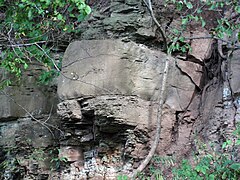Dunkard Group
| Dunkard Group | |
|---|---|
| Stratigraphic range: Pennsylvanian-Permian | |
 Sandstone (Greene Formation, Dunkard Group, Lower Permian; Monroe County, Ohio) | |
| Type | Group |
| Sub-units | Greene Formation, Washington Formation, Waynesburg Formation[1] |
| Underlies | Igneous intrusives |
| Overlies | Monongahela Formation |
| Lithology | |
| Primary | Shale, sandstone, siltstone, coal |
| Other | Limestone |
| Location | |
| Region | |
| Country | |
| Type section | |
| Named for | Dunkard Creek |
| Named by | I.C. White in 1891 |
The Permian Dunkard Group (Pd) is an area of rock, Early Permian in age, in the south of Ohio, southwestern Pennsylvania, West Virginia and the hilltops of the Georges Creek Basin of Maryland.[2] In Ohio, it is found primarily in Washington County. It is notable for being one of the few areas of Permian sediment east of the Mississippi River. In addition, it is the youngest surface rock in the state of Ohio.
Description
[edit]It consists of red and green shale, siltstone, and sandstone, with thin lenticular beds of argillaceous limestone and thin beds of impure coal The base of the layer contains thick-bedded, white conglomeratic sandstone. The layer's thickness is greater than 200 feet in Maryland.[2]
The fossils found in the Dunkard Group are similar to ones found in Texas and Oklahoma of similar age.
Stratigraphy
[edit]The Dunkard contains three formation. Starting at the base (oldest) is the Waynesburg Formation, Washington Formation, and Greene Formation. The base is marked by the Waynesburg Coal, with the Monongahela Group below. The Washington Coal is found at the base of the Washington Formation and its base marks the boundary between the lower Waynesburg and the Washington formation above. The top of the Upper Washington Limestone marks the line between the Washington Formation and the upper Greene formation.
Fossil content
[edit]References
[edit]- ^ Berryhill, Jr., Henry L.; Swanson, Vernon E. (1962). "Geological Survey research 1962; Short papers in geology and hydrology" (PDF). U.S. Geological Survey Professional Paper. 450-C: 43–46. Retrieved 30 June 2018.
- ^ a b "Allegheny Plateau and Valley and Ridge". Geologic Map of Maryland. Maryland Geological Survey. 1968. Retrieved 2008-01-26.
Further reading
[edit]- Anstey, Robert L.; Feldmann, Rodney M.; Hackathorn, Merrianne (1996). Fossils of Ohio. Columbus: State of Ohio, Dept. of Natural Resources, Division of Geological Survey. ISBN 0-931079-05-5.
- Geologic groups of Ohio
- Geologic groups of Pennsylvania
- Geologic groups of West Virginia
- Carboniferous System of North America
- Permian System of North America
- Permian United States
- Permian Ohio
- Permian geology of Pennsylvania
- Permian West Virginia
- Sandstone formations of the United States
- Shale formations of the United States
- Coal formations
- Limestone formations of the United States
- Siltstone formations
- Geologic formations of Pennsylvania











